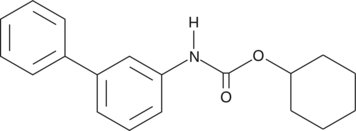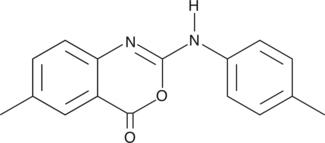Chemicals
Showing 39301–39450 of 41137 results
-
URB447 is a mixed central cannabinoid (CB1) receptor antagonist/peripheral cannabinoid (CB2) receptor agonist with IC50 values of 313 and 41 nM, respectively.{17060} At 20 mg/kg delivered intraperitoneally to ob/ob mice and Swiss mice, URB447 reduces food intake and body-weight gain with an efficacy comparable to rimonabant,{17060} which is an inverse agonist for the CB1. Marketed as an anti-obesity drug and appetite suppressant, rimonabant was subsequently suspended from distribution due to serious psychiatric side effects attributed to its indiscriminate activity on CB1 receptors in the central nervous system (CNS).{16165} Unlike rimonabant, URB447 does not penetrate the blood-brain barrier (to antagonize CB1 receptors in the CNS); instead, it appears to selectively block peripheral CB1 receptors such as those located in the gastrointestinal tract.{17060}
Brand:CaymanSKU:-URB447 is a mixed central cannabinoid (CB1) receptor antagonist/peripheral cannabinoid (CB2) receptor agonist with IC50 values of 313 and 41 nM, respectively.{17060} At 20 mg/kg delivered intraperitoneally to ob/ob mice and Swiss mice, URB447 reduces food intake and body-weight gain with an efficacy comparable to rimonabant,{17060} which is an inverse agonist for the CB1. Marketed as an anti-obesity drug and appetite suppressant, rimonabant was subsequently suspended from distribution due to serious psychiatric side effects attributed to its indiscriminate activity on CB1 receptors in the central nervous system (CNS).{16165} Unlike rimonabant, URB447 does not penetrate the blood-brain barrier (to antagonize CB1 receptors in the CNS); instead, it appears to selectively block peripheral CB1 receptors such as those located in the gastrointestinal tract.{17060}
Brand:CaymanSKU:-URB447 is a mixed central cannabinoid (CB1) receptor antagonist/peripheral cannabinoid (CB2) receptor agonist with IC50 values of 313 and 41 nM, respectively.{17060} At 20 mg/kg delivered intraperitoneally to ob/ob mice and Swiss mice, URB447 reduces food intake and body-weight gain with an efficacy comparable to rimonabant,{17060} which is an inverse agonist for the CB1. Marketed as an anti-obesity drug and appetite suppressant, rimonabant was subsequently suspended from distribution due to serious psychiatric side effects attributed to its indiscriminate activity on CB1 receptors in the central nervous system (CNS).{16165} Unlike rimonabant, URB447 does not penetrate the blood-brain barrier (to antagonize CB1 receptors in the CNS); instead, it appears to selectively block peripheral CB1 receptors such as those located in the gastrointestinal tract.{17060}
Brand:CaymanSKU:-URB597 is a potent and selective inhibitor of fatty acid amide hydrolase (FAAH), the enzyme that hydrolyzes anandamide (AEA; Item No. 90050) and other simple esters and amides with long unsaturated acyl chains (IC50 = 4.6 nM and 0.5 nM in brain membranes and intact neurons, respectively).{10666,3310} URB597 exhibits both antinociceptive and anxiolytic effects in vivo without evoking other symptoms associated with cannabinoid-like compounds. This antinociceptive effect is similar to those observed in FAAH(-/-) mice.{9576}
Brand:CaymanSKU:10046 - 10 mgAvailable on backorder
URB597 is a potent and selective inhibitor of fatty acid amide hydrolase (FAAH), the enzyme that hydrolyzes anandamide (AEA; Item No. 90050) and other simple esters and amides with long unsaturated acyl chains (IC50 = 4.6 nM and 0.5 nM in brain membranes and intact neurons, respectively).{10666,3310} URB597 exhibits both antinociceptive and anxiolytic effects in vivo without evoking other symptoms associated with cannabinoid-like compounds. This antinociceptive effect is similar to those observed in FAAH(-/-) mice.{9576}
Brand:CaymanSKU:10046 - 100 mgAvailable on backorder
URB597 is a potent and selective inhibitor of fatty acid amide hydrolase (FAAH), the enzyme that hydrolyzes anandamide (AEA; Item No. 90050) and other simple esters and amides with long unsaturated acyl chains (IC50 = 4.6 nM and 0.5 nM in brain membranes and intact neurons, respectively).{10666,3310} URB597 exhibits both antinociceptive and anxiolytic effects in vivo without evoking other symptoms associated with cannabinoid-like compounds. This antinociceptive effect is similar to those observed in FAAH(-/-) mice.{9576}
Brand:CaymanSKU:10046 - 5 mgAvailable on backorder
URB597 is a potent and selective inhibitor of fatty acid amide hydrolase (FAAH), the enzyme that hydrolyzes anandamide (AEA; Item No. 90050) and other simple esters and amides with long unsaturated acyl chains (IC50 = 4.6 nM and 0.5 nM in brain membranes and intact neurons, respectively).{10666,3310} URB597 exhibits both antinociceptive and anxiolytic effects in vivo without evoking other symptoms associated with cannabinoid-like compounds. This antinociceptive effect is similar to those observed in FAAH(-/-) mice.{9576}
Brand:CaymanSKU:10046 - 50 mgAvailable on backorder
URB602 is a selective inhibitor of monoacylglycerol lipase (MAGL), exhibiting an IC50 value of 28 µM for the rat brain enzyme.{13217} It does not inhibit fatty acid amide hydrolase (FAAH) at concentrations up to 100 µM or other lipid metabolizing enzymes such as diacylglycerol lipase or COX-2.{13217,11304} Inhibition of MAGL inhibits 2-arachidonoyl glycerol (Item No. 62160) hydrolysis, which is associated with enhanced stress-induced analgesia and may represent a novel drug target in pain and stress management.{13217} URB602 (50 µM) also inhibits glucose-stimulated and depolarization-induced insulin secretion in INS-1 cells.{38096}
Brand:CaymanSKU:10007457 - 10 mgAvailable on backorder
URB602 is a selective inhibitor of monoacylglycerol lipase (MAGL), exhibiting an IC50 value of 28 µM for the rat brain enzyme.{13217} It does not inhibit fatty acid amide hydrolase (FAAH) at concentrations up to 100 µM or other lipid metabolizing enzymes such as diacylglycerol lipase or COX-2.{13217,11304} Inhibition of MAGL inhibits 2-arachidonoyl glycerol (Item No. 62160) hydrolysis, which is associated with enhanced stress-induced analgesia and may represent a novel drug target in pain and stress management.{13217} URB602 (50 µM) also inhibits glucose-stimulated and depolarization-induced insulin secretion in INS-1 cells.{38096}
Brand:CaymanSKU:10007457 - 100 mgAvailable on backorder
URB602 is a selective inhibitor of monoacylglycerol lipase (MAGL), exhibiting an IC50 value of 28 µM for the rat brain enzyme.{13217} It does not inhibit fatty acid amide hydrolase (FAAH) at concentrations up to 100 µM or other lipid metabolizing enzymes such as diacylglycerol lipase or COX-2.{13217,11304} Inhibition of MAGL inhibits 2-arachidonoyl glycerol (Item No. 62160) hydrolysis, which is associated with enhanced stress-induced analgesia and may represent a novel drug target in pain and stress management.{13217} URB602 (50 µM) also inhibits glucose-stimulated and depolarization-induced insulin secretion in INS-1 cells.{38096}
Brand:CaymanSKU:10007457 - 5 mgAvailable on backorder
URB602 is a selective inhibitor of monoacylglycerol lipase (MAGL), exhibiting an IC50 value of 28 µM for the rat brain enzyme.{13217} It does not inhibit fatty acid amide hydrolase (FAAH) at concentrations up to 100 µM or other lipid metabolizing enzymes such as diacylglycerol lipase or COX-2.{13217,11304} Inhibition of MAGL inhibits 2-arachidonoyl glycerol (Item No. 62160) hydrolysis, which is associated with enhanced stress-induced analgesia and may represent a novel drug target in pain and stress management.{13217} URB602 (50 µM) also inhibits glucose-stimulated and depolarization-induced insulin secretion in INS-1 cells.{38096}
Brand:CaymanSKU:10007457 - 50 mgAvailable on backorder
URB754 is a potent and noncompetitive inhibitor of monoacylglycerol lipase (MAGL), exhibiting an IC50 value of 200 nM for the recombinant rat brain enzyme.{13321} However, it does not inhibit human recombinant, rat brain, or mouse brain MAGL at concentrations up to 100 µM.{14400,16299} There is evidence that the MAGL inhibitory activity of URB754 may be attributed to the impurity bis(methylthio)mercurane (IC50 = 11.9 nM for rat recombinant MAGL) that is found in commercial preparations.{37077} URB754 inhibits rat brain fatty acyl amide hydrolase (FAAH) with an IC50 value of 32 µM and binds weakly to the rat central cannabinoid (CB1) receptor with an IC50 value of 3.8 µM.{13321} It does not inhibit COX-1 or COX-2 at concentrations up to 100 µM.{13321} Inhibition of MAGL hydrolysis of 2-arachidonoyl glycerol (2-AG) is associated with enhanced stress-induced analgesia and may represent a novel drug target in pain and stress management.{13217}
Brand:CaymanSKU:10007691 - 10 mgAvailable on backorder
URB754 is a potent and noncompetitive inhibitor of monoacylglycerol lipase (MAGL), exhibiting an IC50 value of 200 nM for the recombinant rat brain enzyme.{13321} However, it does not inhibit human recombinant, rat brain, or mouse brain MAGL at concentrations up to 100 µM.{14400,16299} There is evidence that the MAGL inhibitory activity of URB754 may be attributed to the impurity bis(methylthio)mercurane (IC50 = 11.9 nM for rat recombinant MAGL) that is found in commercial preparations.{37077} URB754 inhibits rat brain fatty acyl amide hydrolase (FAAH) with an IC50 value of 32 µM and binds weakly to the rat central cannabinoid (CB1) receptor with an IC50 value of 3.8 µM.{13321} It does not inhibit COX-1 or COX-2 at concentrations up to 100 µM.{13321} Inhibition of MAGL hydrolysis of 2-arachidonoyl glycerol (2-AG) is associated with enhanced stress-induced analgesia and may represent a novel drug target in pain and stress management.{13217}
Brand:CaymanSKU:10007691 - 100 mgAvailable on backorder
URB754 is a potent and noncompetitive inhibitor of monoacylglycerol lipase (MAGL), exhibiting an IC50 value of 200 nM for the recombinant rat brain enzyme.{13321} However, it does not inhibit human recombinant, rat brain, or mouse brain MAGL at concentrations up to 100 µM.{14400,16299} There is evidence that the MAGL inhibitory activity of URB754 may be attributed to the impurity bis(methylthio)mercurane (IC50 = 11.9 nM for rat recombinant MAGL) that is found in commercial preparations.{37077} URB754 inhibits rat brain fatty acyl amide hydrolase (FAAH) with an IC50 value of 32 µM and binds weakly to the rat central cannabinoid (CB1) receptor with an IC50 value of 3.8 µM.{13321} It does not inhibit COX-1 or COX-2 at concentrations up to 100 µM.{13321} Inhibition of MAGL hydrolysis of 2-arachidonoyl glycerol (2-AG) is associated with enhanced stress-induced analgesia and may represent a novel drug target in pain and stress management.{13217}
Brand:CaymanSKU:10007691 - 5 mgAvailable on backorder
URB754 is a potent and noncompetitive inhibitor of monoacylglycerol lipase (MAGL), exhibiting an IC50 value of 200 nM for the recombinant rat brain enzyme.{13321} However, it does not inhibit human recombinant, rat brain, or mouse brain MAGL at concentrations up to 100 µM.{14400,16299} There is evidence that the MAGL inhibitory activity of URB754 may be attributed to the impurity bis(methylthio)mercurane (IC50 = 11.9 nM for rat recombinant MAGL) that is found in commercial preparations.{37077} URB754 inhibits rat brain fatty acyl amide hydrolase (FAAH) with an IC50 value of 32 µM and binds weakly to the rat central cannabinoid (CB1) receptor with an IC50 value of 3.8 µM.{13321} It does not inhibit COX-1 or COX-2 at concentrations up to 100 µM.{13321} Inhibition of MAGL hydrolysis of 2-arachidonoyl glycerol (2-AG) is associated with enhanced stress-induced analgesia and may represent a novel drug target in pain and stress management.{13217}
Brand:CaymanSKU:10007691 - 50 mgAvailable on backorder
URB937 is a potent fatty acid amide hydrolase (FAAH) inhibitor (IC50 = 26.8 nM, in vitro) that does not penetrate the blood-brain barrier, thus preventing arachidonoyl ethanolamide (AEA; Item No. 90050) deactivation only in peripheral tissues.{18772} Its ED50 value for FAAH inhibition in brain is 200-fold higher than the ED50 value for FAAH inhibition in liver when administered systemically in mice (40 mg/kg versus 0.2 mg/kg, respectively). Subcutaneous administration of URB937 reduces acetic acid-induced writhing in mice with an ED50 value of 0.1 mg/kg. A single 1 mg/kg injection of URB937 sufficiently attenuates behavioral responses elicited in mouse models of neuropathic and inflammatory pain. As a peripherally-specific FAAH inhibitor, URB937 may offer an alternative approach to pain therapy devoid of unwanted central effects.
Brand:CaymanSKU:10674 - 10 mgAvailable on backorder
URB937 is a potent fatty acid amide hydrolase (FAAH) inhibitor (IC50 = 26.8 nM, in vitro) that does not penetrate the blood-brain barrier, thus preventing arachidonoyl ethanolamide (AEA; Item No. 90050) deactivation only in peripheral tissues.{18772} Its ED50 value for FAAH inhibition in brain is 200-fold higher than the ED50 value for FAAH inhibition in liver when administered systemically in mice (40 mg/kg versus 0.2 mg/kg, respectively). Subcutaneous administration of URB937 reduces acetic acid-induced writhing in mice with an ED50 value of 0.1 mg/kg. A single 1 mg/kg injection of URB937 sufficiently attenuates behavioral responses elicited in mouse models of neuropathic and inflammatory pain. As a peripherally-specific FAAH inhibitor, URB937 may offer an alternative approach to pain therapy devoid of unwanted central effects.
Brand:CaymanSKU:10674 - 100 mgAvailable on backorder
URB937 is a potent fatty acid amide hydrolase (FAAH) inhibitor (IC50 = 26.8 nM, in vitro) that does not penetrate the blood-brain barrier, thus preventing arachidonoyl ethanolamide (AEA; Item No. 90050) deactivation only in peripheral tissues.{18772} Its ED50 value for FAAH inhibition in brain is 200-fold higher than the ED50 value for FAAH inhibition in liver when administered systemically in mice (40 mg/kg versus 0.2 mg/kg, respectively). Subcutaneous administration of URB937 reduces acetic acid-induced writhing in mice with an ED50 value of 0.1 mg/kg. A single 1 mg/kg injection of URB937 sufficiently attenuates behavioral responses elicited in mouse models of neuropathic and inflammatory pain. As a peripherally-specific FAAH inhibitor, URB937 may offer an alternative approach to pain therapy devoid of unwanted central effects.
Brand:CaymanSKU:10674 - 5 mgAvailable on backorder
URB937 is a potent fatty acid amide hydrolase (FAAH) inhibitor (IC50 = 26.8 nM, in vitro) that does not penetrate the blood-brain barrier, thus preventing arachidonoyl ethanolamide (AEA; Item No. 90050) deactivation only in peripheral tissues.{18772} Its ED50 value for FAAH inhibition in brain is 200-fold higher than the ED50 value for FAAH inhibition in liver when administered systemically in mice (40 mg/kg versus 0.2 mg/kg, respectively). Subcutaneous administration of URB937 reduces acetic acid-induced writhing in mice with an ED50 value of 0.1 mg/kg. A single 1 mg/kg injection of URB937 sufficiently attenuates behavioral responses elicited in mouse models of neuropathic and inflammatory pain. As a peripherally-specific FAAH inhibitor, URB937 may offer an alternative approach to pain therapy devoid of unwanted central effects.
Brand:CaymanSKU:10674 - 50 mgAvailable on backorder
Urdamycin A is a bacterial metabolite originally isolated from S. fradiae that has antibacterial and anticancer activities.{53476,53477} It is active against a variety of Gram-positive and Gram-negative bacteria, including B. subtilis and strains of Arthrobacter and Streptomyces, but not the fungus S. cerevisiae, in a disc assay when used at a concentration of 1 mg/ml.{53477} Urdamycin A is cytotoxic to L1210 and HT-29, but not A549, cancer cells (IC50s = 7.5, 5, and >10 µg/ml, respectively).{53476}
Brand:CaymanSKU:29510 - 1 mgAvailable on backorder
Urdamycin B is a glycoside bacterial metabolite that has been found in S. fradiae and has antibacterial and anticancer activities.{53477} It is active against Gram-positive and Gram-negative bacteria and inhibits proliferation of L1210 leukemia cells (IC50 = 2.4 µg/ml).
Brand:CaymanSKU:29770 - 1 mgAvailable on backorder
Uric acid is a ubiquitous end product of purine metabolism in humans that is mainly excreted in urine, whereas in other mammals it is further metabolized to allantoin by uricase.{26400} The final two steps in its production are catalyzed by xanthine oxidase, which generates superoxide.{26402} Uric acid acts as a potent peroxynitrite scavenger and antioxidant.{26400,26402,6143} However, high levels of serum uric acid (>120 µg/ml), termed hyperuricemia, are associated with gout, kidney stones, metabolic syndrome, hypertension, renal disease, and cardiovascular disease.{26400,18377,18381,18380,18379} Uric acid in the form of monosodium urate crystals has been proposed to trigger interleukin-1β-mediated inflammation by activating the NOD-like receptor protein 3 inflammasome.{26401}
Brand:CaymanSKU:-Uridine is a nucleoside that is used as a component of RNA and numerous other biomolecules. For example, uridine 5’-diphosphate glucose is the direct glucose donor for glycogen synthesis.{32421} Also, uridine 5’-diphosphate (Item No. 18137) and uridine 5’-triphosphate act as signaling molecules that activate purinergic receptors.{32422}
Brand:CaymanSKU:20300 -Available on backorder
Uridine is a nucleoside that is used as a component of RNA and numerous other biomolecules. For example, uridine 5’-diphosphate glucose is the direct glucose donor for glycogen synthesis.{32421} Also, uridine 5’-diphosphate (Item No. 18137) and uridine 5’-triphosphate act as signaling molecules that activate purinergic receptors.{32422}
Brand:CaymanSKU:20300 -Available on backorder
Uridine is a nucleoside that is used as a component of RNA and numerous other biomolecules. For example, uridine 5’-diphosphate glucose is the direct glucose donor for glycogen synthesis.{32421} Also, uridine 5’-diphosphate (Item No. 18137) and uridine 5’-triphosphate act as signaling molecules that activate purinergic receptors.{32422}
Brand:CaymanSKU:20300 -Available on backorder
Uridine is a nucleoside that is used as a component of RNA and numerous other biomolecules. For example, uridine 5’-diphosphate glucose is the direct glucose donor for glycogen synthesis.{32421} Also, uridine 5’-diphosphate (Item No. 18137) and uridine 5’-triphosphate act as signaling molecules that activate purinergic receptors.{32422}
Brand:CaymanSKU:20300 -Available on backorder
Uridine 5′-triphosphate (UTP) is a nucleotide and dual agonist of purinergic P2Y2 and P2Y4 receptors (EC50s = 55 and 80 nM, respectively, for stimulation of phospholipase C in 1321N1 cells expressing human receptors).{53844,53845} It is selective for P2Y2 and P2Y4 receptors over P2Y6 receptors (EC50 = >10,000 nM).{53845} UTP stimulates proliferation of PANC-1 cells (EC50 = 13.1 μM), an effect that can be prevented by siRNA against the P2Y2 receptor.{53844} It induces vasoconstriction in perfused isolated canine epicardial coronary artery in a concentration-dependent manner.{53846} UTP is formed from uridine monophosphate (UMP) by two sequential phosphorylations and can be converted to cytidine 5′-triphosphate (CTP; Item No. 18147).{53847} It also reacts with glucose-1-phosphate (Item No. 30566) to form UDP-glucose (Item No. 15602), a precursor in the biosynthesis of glycogen.{52573}
Brand:CaymanSKU:9003530 - 1 gAvailable on backorder
Uridine 5′-triphosphate (UTP) is a nucleotide and dual agonist of purinergic P2Y2 and P2Y4 receptors (EC50s = 55 and 80 nM, respectively, for stimulation of phospholipase C in 1321N1 cells expressing human receptors).{53844,53845} It is selective for P2Y2 and P2Y4 receptors over P2Y6 receptors (EC50 = >10,000 nM).{53845} UTP stimulates proliferation of PANC-1 cells (EC50 = 13.1 μM), an effect that can be prevented by siRNA against the P2Y2 receptor.{53844} It induces vasoconstriction in perfused isolated canine epicardial coronary artery in a concentration-dependent manner.{53846} UTP is formed from uridine monophosphate (UMP) by two sequential phosphorylations and can be converted to cytidine 5′-triphosphate (CTP; Item No. 18147).{53847} It also reacts with glucose-1-phosphate (Item No. 30566) to form UDP-glucose (Item No. 15602), a precursor in the biosynthesis of glycogen.{52573}
Brand:CaymanSKU:9003530 - 100 mgAvailable on backorder
Uridine 5′-triphosphate (UTP) is a nucleotide and dual agonist of purinergic P2Y2 and P2Y4 receptors (EC50s = 55 and 80 nM, respectively, for stimulation of phospholipase C in 1321N1 cells expressing human receptors).{53844,53845} It is selective for P2Y2 and P2Y4 receptors over P2Y6 receptors (EC50 = >10,000 nM).{53845} UTP stimulates proliferation of PANC-1 cells (EC50 = 13.1 μM), an effect that can be prevented by siRNA against the P2Y2 receptor.{53844} It induces vasoconstriction in perfused isolated canine epicardial coronary artery in a concentration-dependent manner.{53846} UTP is formed from uridine monophosphate (UMP) by two sequential phosphorylations and can be converted to cytidine 5′-triphosphate (CTP; Item No. 18147).{53847} It also reacts with glucose-1-phosphate (Item No. 30566) to form UDP-glucose (Item No. 15602), a precursor in the biosynthesis of glycogen.{52573}
Brand:CaymanSKU:9003530 - 5 gAvailable on backorder
Uridine 5′-triphosphate (UTP) is a nucleotide and dual agonist of purinergic P2Y2 and P2Y4 receptors (EC50s = 55 and 80 nM, respectively, for stimulation of phospholipase C in 1321N1 cells expressing human receptors).{53844,53845} It is selective for P2Y2 and P2Y4 receptors over P2Y6 receptors (EC50 = >10,000 nM).{53845} UTP stimulates proliferation of PANC-1 cells (EC50 = 13.1 μM), an effect that can be prevented by siRNA against the P2Y2 receptor.{53844} It induces vasoconstriction in perfused isolated canine epicardial coronary artery in a concentration-dependent manner.{53846} UTP is formed from uridine monophosphate (UMP) by two sequential phosphorylations and can be converted to cytidine 5′-triphosphate (CTP; Item No. 18147).{53847} It also reacts with glucose-1-phosphate (Item No. 30566) to form UDP-glucose (Item No. 15602), a precursor in the biosynthesis of glycogen.{52573}
Brand:CaymanSKU:9003530 - 500 mgAvailable on backorder
Uridine-3′-monophosphate is a nucleoside used in the biochemical synthesis of ribothymidine-3’-phosphate.{27287} It has been used as a bioavailable source of uridine in research studies designed to enhance learning and memory.{27285,27286}
Brand:CaymanSKU:-Out of stock
Uridine-3′-monophosphate is a nucleoside used in the biochemical synthesis of ribothymidine-3’-phosphate.{27287} It has been used as a bioavailable source of uridine in research studies designed to enhance learning and memory.{27285,27286}
Brand:CaymanSKU:-Out of stock
Uridine-3′-monophosphate is a nucleoside used in the biochemical synthesis of ribothymidine-3’-phosphate.{27287} It has been used as a bioavailable source of uridine in research studies designed to enhance learning and memory.{27285,27286}
Brand:CaymanSKU:-Out of stock
Uridine-3′-monophosphate is a nucleoside used in the biochemical synthesis of ribothymidine-3’-phosphate.{27287} It has been used as a bioavailable source of uridine in research studies designed to enhance learning and memory.{27285,27286}
Brand:CaymanSKU:-Out of stock
URMC-099 is an orally bioavailable, brain-penetrant inhibitor of mixed-lineage kinases (MLKs) with IC50 values of 19, 42, 14, and 150 nM for MLK1, MLK2, MLK3, and the related MLK family member DLK, respectively.{19147} It also inhibits LRRK2 activity with an IC50 value of 11 nM.{19147} In vitro, URMC-099 has been shown to reduce inflammatory cytokine production by HIV-1 Tat-exposed microglia and to prevent destruction and phagocytosis of cultured neuronal axons by these cells.{31033} In rodent models of HIV-associated neurocognitive disorders, URMC-099 demonstrates anti-inflammatory and neuroprotective effects.{31033}
Brand:CaymanSKU:-Available on backorder
URMC-099 is an orally bioavailable, brain-penetrant inhibitor of mixed-lineage kinases (MLKs) with IC50 values of 19, 42, 14, and 150 nM for MLK1, MLK2, MLK3, and the related MLK family member DLK, respectively.{19147} It also inhibits LRRK2 activity with an IC50 value of 11 nM.{19147} In vitro, URMC-099 has been shown to reduce inflammatory cytokine production by HIV-1 Tat-exposed microglia and to prevent destruction and phagocytosis of cultured neuronal axons by these cells.{31033} In rodent models of HIV-associated neurocognitive disorders, URMC-099 demonstrates anti-inflammatory and neuroprotective effects.{31033}
Brand:CaymanSKU:-Available on backorder
URMC-099 is an orally bioavailable, brain-penetrant inhibitor of mixed-lineage kinases (MLKs) with IC50 values of 19, 42, 14, and 150 nM for MLK1, MLK2, MLK3, and the related MLK family member DLK, respectively.{19147} It also inhibits LRRK2 activity with an IC50 value of 11 nM.{19147} In vitro, URMC-099 has been shown to reduce inflammatory cytokine production by HIV-1 Tat-exposed microglia and to prevent destruction and phagocytosis of cultured neuronal axons by these cells.{31033} In rodent models of HIV-associated neurocognitive disorders, URMC-099 demonstrates anti-inflammatory and neuroprotective effects.{31033}
Brand:CaymanSKU:-Available on backorder
URMC-099 is an orally bioavailable, brain-penetrant inhibitor of mixed-lineage kinases (MLKs) with IC50 values of 19, 42, 14, and 150 nM for MLK1, MLK2, MLK3, and the related MLK family member DLK, respectively.{19147} It also inhibits LRRK2 activity with an IC50 value of 11 nM.{19147} In vitro, URMC-099 has been shown to reduce inflammatory cytokine production by HIV-1 Tat-exposed microglia and to prevent destruction and phagocytosis of cultured neuronal axons by these cells.{31033} In rodent models of HIV-associated neurocognitive disorders, URMC-099 demonstrates anti-inflammatory and neuroprotective effects.{31033}
Brand:CaymanSKU:-Available on backorder
Urocortin is a neuropeptide hormone and member of the corticotropin-releasing factor (CRF) family which includes mammalian CRF (Item No. 24407), urocortin II (Item Nos. 24746 | 24747), urocortin III (Item Nos. 24748 | 24749 | 24750), frog sauvagine, and piscine urotensin I.{38851} Rat urocortin shares 63 and 45% sequence identity to urotensin and CRF, respectively. It is primarilly expressed in the Edinger-Westphal nucleus and lateral superior olive regions in the adult rat brain but can also be expressed in the periphery. Urocortin binds to type 1 and 2 CRF receptors as well as CRF binding protein (CRF-BP) with Ki values of 0.16, 0.41, and 0.10 nM for CRF1, CRF2β, and CRF-BP, respectively. It induces cAMP production in CHO cells expressing CRF1 and CRF2β (EC50s = 0.8 and 0.18 nM, respectively) and secretion of adrenocorticotropic hormone (ACTH) by rat anterior pituitary cells (EC50 = 0.006 nM). In vivo, urocortin (0.94-18.85 μg/kg) decreases mean arterial pressure and increases plasma levels of ACTH in rats. Urocortin inhibits gastric emptying of a solid meal in mice and rats and inhibits gastric motility and transit induced by vagal stimulation in rats.{38852} Levels of urocortin mRNA increase in testis in response to ischemia-reperfusion injury in a rat model of testicular torsion.{38853}
Brand:CaymanSKU:24745 - 1 mgAvailable on backorder
Urocortin II is a neuropeptide hormone and member of the corticotropin-releasing factor (CRF) family which includes mammalian CRF (Item No. 24407), urocortin (Item No. 24745), urocortin III (Item Nos. 24749 | 24750), frog sauvagine, and piscine urotensin I.{38848} Human urocortin II shares 34, 43, and 37-40% sequence homology with rat and human CRF, human urocortin (Item No. 24744), and human urocortin III (Item No. 24748). Urocortin II increases cell shortening and accelerates relaxation of rabbit ventricular myocytes in a time- and concentration-dependent manner. In vivo, urocortin reduces arterial blood pressure in normotensive and spontaneously hypertensive rats via peripheral CRF2 receptor agonism. It induces dose-dependent tachycardia and hypotension in rats when administered at doses of 3 and 30 pmol/kg.{38849} Urocortin (10 and 20 μg/kg) also reduces the visceral pain response to colorectal distension in conscious rats and delays gastric emptying in mice.{38848,38850}
Brand:CaymanSKU:24746 - 1 mgAvailable on backorder
Urocortin II is a neuropeptide hormone and member of the corticotropin-releasing factor (CRF) family which includes mammalian CRF (Item No. 24407), urocortin (Item No. 24745), urocortin III (Item Nos. 24749 | 24750), frog sauvagine, and piscine urotensin I.{38848} Human urocortin II shares 34, 43, and 37-40% sequence homology with rat and human CRF, human urocortin (Item No. 24744), and human urocortin III (Item No. 24748). Urocortin II increases cell shortening and accelerates relaxation of rabbit ventricular myocytes in a time- and concentration-dependent manner. In vivo, urocortin reduces arterial blood pressure in normotensive and spontaneously hypertensive rats via peripheral CRF2 receptor agonism. It induces dose-dependent tachycardia and hypotension in rats when administered at doses of 3 and 30 pmol/kg.{38849} Urocortin (10 and 20 μg/kg) also reduces the visceral pain response to colorectal distension in conscious rats and delays gastric emptying in mice.{38848,38850}
Brand:CaymanSKU:24746 - 500 µgAvailable on backorder
Urocortin III is a neuropeptide hormone and member of the corticotropin-releasing factor (CRF) family which includes mammalian CRF (Item No. 24407), urocortin (Item No. 24745), urocortin II (Item No. 24746), frog sauvagine, and piscine urotensin I.{39576} Human urocortin III shares 90, 40, 37, and 21% identity to mouse urocortin III (Item Nos. 24749 | 24750), mouse urocortin II (Item No. 24747), human urocortin (Item No. 24744), and mouse urocortin, respectively. Urocortin III selectively binds to type 2 CRF receptors (Kis = 21.7, 13.5, and >100 nM for rat CRF2α, rat CRF2β, and human CRF1, respectively). It stimulates cAMP production in CHO cells expressing rat CRF2α and mouse CRF2β (EC50s = 0.16 and 0.12 nM, respectively) as well as cultured anterior pituitary cells expressing endogenous CRF2β. Urocortin III is co-released with insulin to potentiate glucose-stimulated somatostatin release in vitro in human pancreatic β-cells.{39579} In vivo, urocortin III reduces food intake in a dose- and time-dependent manner in mice with a minimum effective dose (MED) of 0.3 nmol/animal.{41572} It increases swimming time in a forced swim test in mice, indicating antidepressant-like activity.{41573}
Brand:CaymanSKU:24748 - 1 mgAvailable on backorder
Urodilatin is a renal natriuretic peptide first isolated from human urine.{30059,30058} It is derived from the same precursor as atrial natriuretic peptide in kidney tubular cells and secreted luminally.{30058} Urodilatin regulates sodium and water reabsorption in the kidney.{30058,30060} While it is not normally found in the circulation, systemic administration of urodilatin has pharmacological effects on renal, cardiovascular, and pulmonary parameters in animals.{30058,29913}
Brand:CaymanSKU:-Available on backorder
Urodilatin is a renal natriuretic peptide first isolated from human urine.{30059,30058} It is derived from the same precursor as atrial natriuretic peptide in kidney tubular cells and secreted luminally.{30058} Urodilatin regulates sodium and water reabsorption in the kidney.{30058,30060} While it is not normally found in the circulation, systemic administration of urodilatin has pharmacological effects on renal, cardiovascular, and pulmonary parameters in animals.{30058,29913}
Brand:CaymanSKU:-Available on backorder
Urolithin A is a secondary metabolite of ellagic acid (Item No. 10569), a polyphenolic antioxidant, that has antiproliferative, anti-inflammatory, and anti-oxidant properties.{40131} It decreases proliferation in ECC-1, Ishikawa, and HEC-1A human endometrial cancer cell lines at a concentration of 1 µM, arrests the cell cycle at the G2/M transition, and modulates estrogen receptor-regulated gene expression.{40132} It also potentiates the antiproliferative effect of 5-fluorouracil (Item No. 14416) in Caco-2, SW480, and HT-29 cells.{40128} In a rat model of colitis, urolithin A reduces inflammation, decreasing prostaglandin E2 (PGE2; Item No. 14010) levels and preventing upregulation of COX-2 gene expression and protein levels in colonic mucosa.{40129} It also induces mitophagy in C. elegans, C2C12 myoblasts, and Mode-K intestinal cells in correlation with improved fitness and extended lifespan in C. elegans and increased exercise capacity in mice.{40130}
Brand:CaymanSKU:22607 -Out of stock
Urolithin A is a secondary metabolite of ellagic acid (Item No. 10569), a polyphenolic antioxidant, that has antiproliferative, anti-inflammatory, and anti-oxidant properties.{40131} It decreases proliferation in ECC-1, Ishikawa, and HEC-1A human endometrial cancer cell lines at a concentration of 1 µM, arrests the cell cycle at the G2/M transition, and modulates estrogen receptor-regulated gene expression.{40132} It also potentiates the antiproliferative effect of 5-fluorouracil (Item No. 14416) in Caco-2, SW480, and HT-29 cells.{40128} In a rat model of colitis, urolithin A reduces inflammation, decreasing prostaglandin E2 (PGE2; Item No. 14010) levels and preventing upregulation of COX-2 gene expression and protein levels in colonic mucosa.{40129} It also induces mitophagy in C. elegans, C2C12 myoblasts, and Mode-K intestinal cells in correlation with improved fitness and extended lifespan in C. elegans and increased exercise capacity in mice.{40130}
Brand:CaymanSKU:22607 -Out of stock
Urolithin A is a secondary metabolite of ellagic acid (Item No. 10569), a polyphenolic antioxidant, that has antiproliferative, anti-inflammatory, and anti-oxidant properties.{40131} It decreases proliferation in ECC-1, Ishikawa, and HEC-1A human endometrial cancer cell lines at a concentration of 1 µM, arrests the cell cycle at the G2/M transition, and modulates estrogen receptor-regulated gene expression.{40132} It also potentiates the antiproliferative effect of 5-fluorouracil (Item No. 14416) in Caco-2, SW480, and HT-29 cells.{40128} In a rat model of colitis, urolithin A reduces inflammation, decreasing prostaglandin E2 (PGE2; Item No. 14010) levels and preventing upregulation of COX-2 gene expression and protein levels in colonic mucosa.{40129} It also induces mitophagy in C. elegans, C2C12 myoblasts, and Mode-K intestinal cells in correlation with improved fitness and extended lifespan in C. elegans and increased exercise capacity in mice.{40130}
Brand:CaymanSKU:22607 -Out of stock
Urolithin A is a secondary metabolite of ellagic acid (Item No. 10569), a polyphenolic antioxidant, that has antiproliferative, anti-inflammatory, and anti-oxidant properties.{40131} It decreases proliferation in ECC-1, Ishikawa, and HEC-1A human endometrial cancer cell lines at a concentration of 1 µM, arrests the cell cycle at the G2/M transition, and modulates estrogen receptor-regulated gene expression.{40132} It also potentiates the antiproliferative effect of 5-fluorouracil (Item No. 14416) in Caco-2, SW480, and HT-29 cells.{40128} In a rat model of colitis, urolithin A reduces inflammation, decreasing prostaglandin E2 (PGE2; Item No. 14010) levels and preventing upregulation of COX-2 gene expression and protein levels in colonic mucosa.{40129} It also induces mitophagy in C. elegans, C2C12 myoblasts, and Mode-K intestinal cells in correlation with improved fitness and extended lifespan in C. elegans and increased exercise capacity in mice.{40130}
Brand:CaymanSKU:22607 -Out of stock
Ursocholic acid (UCA) is a bile acid and the 7β-hydroxyepimer of cholic acid (Item No. 20250).{52346} Dietary administration of UCA (0.25%) decreases gallbladder cholesterol, phospholipid, and bile acid levels and the occurrence of gallstones in male mice fed a lithogenic diet.
Brand:CaymanSKU:29883 - 1 mgAvailable on backorder
Ursocholic acid (UCA) is a bile acid and the 7β-hydroxyepimer of cholic acid (Item No. 20250).{52346} Dietary administration of UCA (0.25%) decreases gallbladder cholesterol, phospholipid, and bile acid levels and the occurrence of gallstones in male mice fed a lithogenic diet.
Brand:CaymanSKU:29883 - 10 mgAvailable on backorder
Ursocholic acid (UCA) is a bile acid and the 7β-hydroxyepimer of cholic acid (Item No. 20250).{52346} Dietary administration of UCA (0.25%) decreases gallbladder cholesterol, phospholipid, and bile acid levels and the occurrence of gallstones in male mice fed a lithogenic diet.
Brand:CaymanSKU:29883 - 5 mgAvailable on backorder
Ursodeoxycholic acid (UDCA) is a secondary bile acid formed via epimerization of chenodeoxycholic acid (CDCA; Item No. 10011286).{48224,48225} UDCA is also a metabolite of lithocholic acid (LCA; Item No. 20253) in human liver microsomes.{48226} It inhibits taurocholic acid (Item No. 16215) uptake in HeLa cells expressing recombinant sodium/taurocholate cotransporting polypeptide (NTCP) with an IC50 value of 3.6 μM.{24182} UDCA (50 μM) inhibits apoptosis induced by deoxycholic acid (DCA; Item Nos. 20756 | 18231) or ethanol in primary rat hepatocytes.{48227} Dietary administration of UDCA blocks DCA-induced increases in the number of TUNEL-positive hepatocytes in rats. Formulations containing UDCA have been used in the treatment of primary biliary cirrhosis.
Brand:CaymanSKU:-Ursodeoxycholic acid (UDCA) is a secondary bile acid formed via epimerization of chenodeoxycholic acid (CDCA; Item No. 10011286).{48224,48225} UDCA is also a metabolite of lithocholic acid (LCA; Item No. 20253) in human liver microsomes.{48226} It inhibits taurocholic acid (Item No. 16215) uptake in HeLa cells expressing recombinant sodium/taurocholate cotransporting polypeptide (NTCP) with an IC50 value of 3.6 μM.{24182} UDCA (50 μM) inhibits apoptosis induced by deoxycholic acid (DCA; Item Nos. 20756 | 18231) or ethanol in primary rat hepatocytes.{48227} Dietary administration of UDCA blocks DCA-induced increases in the number of TUNEL-positive hepatocytes in rats. Formulations containing UDCA have been used in the treatment of primary biliary cirrhosis.
Brand:CaymanSKU:-Ursodeoxycholic acid (UDCA) is a secondary bile acid formed via epimerization of chenodeoxycholic acid (CDCA; Item No. 10011286).{48224,48225} UDCA is also a metabolite of lithocholic acid (LCA; Item No. 20253) in human liver microsomes.{48226} It inhibits taurocholic acid (Item No. 16215) uptake in HeLa cells expressing recombinant sodium/taurocholate cotransporting polypeptide (NTCP) with an IC50 value of 3.6 μM.{24182} UDCA (50 μM) inhibits apoptosis induced by deoxycholic acid (DCA; Item Nos. 20756 | 18231) or ethanol in primary rat hepatocytes.{48227} Dietary administration of UDCA blocks DCA-induced increases in the number of TUNEL-positive hepatocytes in rats. Formulations containing UDCA have been used in the treatment of primary biliary cirrhosis.
Brand:CaymanSKU:-Ursodeoxycholic acid (UDCA) is a secondary bile acid formed via epimerization of chenodeoxycholic acid (CDCA; Item No. 10011286).{48224,48225} UDCA is also a metabolite of lithocholic acid (LCA; Item No. 20253) in human liver microsomes.{48226} It inhibits taurocholic acid (Item No. 16215) uptake in HeLa cells expressing recombinant sodium/taurocholate cotransporting polypeptide (NTCP) with an IC50 value of 3.6 μM.{24182} UDCA (50 μM) inhibits apoptosis induced by deoxycholic acid (DCA; Item Nos. 20756 | 18231) or ethanol in primary rat hepatocytes.{48227} Dietary administration of UDCA blocks DCA-induced increases in the number of TUNEL-positive hepatocytes in rats. Formulations containing UDCA have been used in the treatment of primary biliary cirrhosis.
Brand:CaymanSKU:-Ursodeoxycholic acid (UDCA) is a secondary bile acid formed via epimerization of chenodeoxycholic acid (CDCA; Item No. 10011286).{48224,48225} UDCA is also a metabolite of lithocholic acid (LCA; Item No. 20253) in human liver microsomes.{48226} It inhibits taurocholic acid (Item No. 16215) uptake in HeLa cells expressing recombinant sodium/taurocholate cotransporting polypeptide (NTCP) with an IC50 value of 3.6 μM.{24182} UDCA (50 μM) inhibits apoptosis induced by deoxycholic acid (DCA; Item Nos. 20756 | 18231) or ethanol in primary rat hepatocytes.{48227} Dietary administration of UDCA blocks DCA-induced increases in the number of TUNEL-positive hepatocytes in rats. Formulations containing UDCA have been used in the treatment of primary biliary cirrhosis. UDCA MaxSpec® standard is a quantitative grade standard of UDCA that has been prepared specifically for mass spectrometry and related applications where quantitative reproducibility is required. The solution has been prepared gravimetrically and is supplied in a deactivated glass ampule sealed under argon. The concentration was verified by comparison to an independently prepared calibration standard. This UDCA MaxSpec® standard is guaranteed to meet identity, purity, stability, and concentration specifications and is provided with a batch-specific certificate of analysis. Ongoing stability testing is performed to ensure the concentration remains accurate throughout the shelf life of the product. Note: The amount of solution added to the vial is in excess of the listed amount. Therefore, it is necessary to accurately measure volumes for preparation of calibration standards. Follow recommended storage and handling conditions to maintain product quality.
Brand:CaymanSKU:31367 - 100 µgAvailable on backorder
Ursodeoxycholic acid-d4 (UDCA-d4) is intended for use as an internal standard for the quantification of UDCA (Item No. 15121) by GC- or LC-MS. UDCA is a secondary bile acid formed via epimerization of chenodeoxycholic acid (CDCA; Item No. 10011286).{48224,48225} UDCA is also a metabolite of lithocholic acid (LCA; Item No. 20253) in human liver microsomes.{48226} It inhibits taurocholic acid (Item No. 16215) uptake in HeLa cells expressing recombinant sodium/taurocholate cotransporting polypeptide (NTCP) with an IC50 value of 3.6 μM.{24182} UDCA (50 μM) inhibits apoptosis induced by deoxycholic acid (DCA; Item Nos. 20756 | 18231) or ethanol in primary rat hepatocytes.{48227} Dietary administration of UDCA blocks DCA-induced increases in the number of TUNEL-positive hepatocytes in rats. Formulations containing UDCA have been used in the treatment of primary biliary cirrhosis.
Brand:CaymanSKU:21892 -Out of stock
Ursodeoxycholic acid-d4 (UDCA-d4) is intended for use as an internal standard for the quantification of UDCA (Item No. 15121) by GC- or LC-MS. UDCA is a secondary bile acid formed via epimerization of chenodeoxycholic acid (CDCA; Item No. 10011286).{48224,48225} UDCA is also a metabolite of lithocholic acid (LCA; Item No. 20253) in human liver microsomes.{48226} It inhibits taurocholic acid (Item No. 16215) uptake in HeLa cells expressing recombinant sodium/taurocholate cotransporting polypeptide (NTCP) with an IC50 value of 3.6 μM.{24182} UDCA (50 μM) inhibits apoptosis induced by deoxycholic acid (DCA; Item Nos. 20756 | 18231) or ethanol in primary rat hepatocytes.{48227} Dietary administration of UDCA blocks DCA-induced increases in the number of TUNEL-positive hepatocytes in rats. Formulations containing UDCA have been used in the treatment of primary biliary cirrhosis.
Brand:CaymanSKU:21892 -Out of stock
Ursodeoxycholic acid-d4 (UDCA-d4) is intended for use as an internal standard for the quantification of UDCA (Item No. 15121) by GC- or LC-MS. UDCA is a secondary bile acid formed via epimerization of chenodeoxycholic acid (CDCA; Item No. 10011286).{48224,48225} UDCA is also a metabolite of lithocholic acid (LCA; Item No. 20253) in human liver microsomes.{48226} It inhibits taurocholic acid (Item No. 16215) uptake in HeLa cells expressing recombinant sodium/taurocholate cotransporting polypeptide (NTCP) with an IC50 value of 3.6 μM.{24182} UDCA (50 μM) inhibits apoptosis induced by deoxycholic acid (DCA; Item Nos. 20756 | 18231) or ethanol in primary rat hepatocytes.{48227} Dietary administration of UDCA blocks DCA-induced increases in the number of TUNEL-positive hepatocytes in rats. Formulations containing UDCA have been used in the treatment of primary biliary cirrhosis.
Brand:CaymanSKU:21892 -Out of stock
Ursodeoxycholic acid-d4 (UDCA-d4) is intended for use as an internal standard for the quantification of UDCA (Item No. 15121) by GC- or LC-MS. UDCA is a secondary bile acid formed via epimerization of chenodeoxycholic acid (CDCA; Item No. 10011286).{48224,48225} UDCA is also a metabolite of lithocholic acid (LCA; Item No. 20253) in human liver microsomes.{48226} It inhibits taurocholic acid (Item No. 16215) uptake in HeLa cells expressing recombinant sodium/taurocholate cotransporting polypeptide (NTCP) with an IC50 value of 3.6 μM.{24182} UDCA (50 μM) inhibits apoptosis induced by deoxycholic acid (DCA; Item Nos. 20756 | 18231) or ethanol in primary rat hepatocytes.{48227} Dietary administration of UDCA blocks DCA-induced increases in the number of TUNEL-positive hepatocytes in rats. Formulations containing UDCA have been used in the treatment of primary biliary cirrhosis. Ursodeoxycholic Acid-d4 MaxSpec® standard is a quantitative grade standard of Ursodeoxycholic Acid-d4 (Item No. 21892) that has been prepared specifically for mass spectrometry and related applications where quantitative reproducibility is required. The solution has been prepared gravimetrically and is supplied in a deactivated glass ampule sealed under argon. The concentration was verified by comparison to an independently prepared calibration standard. This Ursodeoxycholic Acid-d4 MaxSpec® standard is guaranteed to meet identity, purity, stability, and concentration specifications and is provided with a batch-specific certificate of analysis. Ongoing stability testing is performed to ensure the concentration remains accurate throughout the shelf life of the product. Note: The amount of solution added to the vial is in excess of the listed amount. Therefore, it is necessary to accurately measure volumes for preparation of calibration standards. Follow recommended storage and handling conditions to maintain product quality.
Brand:CaymanSKU:31368 - 100 µgAvailable on backorder
Ursolic acid is a pentacyclic triterpenoid that has been isolated from M. pumila and has diverse biological activities, including anticancer, hepatoprotective, anti-inflammatory, antioxidant, antimicrobial, and cardioprotective properties.{45002,15043,45003,45004} It inhibits the proliferation of HepG2 liver, MCF-7 breast, and Caco-2 colon cancer cells (EC50s = 87.4, 14.4, and 34.4 μM, respectively).{15043} Ursolic acid reverses increases in hepatic steatosis, levels of hepatic triglycerides and free fatty acids, and hepatic TNF-α, IL-1β, IL-6, and IL-8 mRNA expression in a dose-dependent manner in a high-fat diet-induced rat model of non-alcoholic fatty liver disease (NAFLD).{45004} Ursolic acid also scavenges 2,2-diphenyl-1-picrylhydrazyl (DPPH) radicals (IC50 = 59.7 μg/ml) and inhibits the growth of several strains of Gram-positive and Gram-negative bacteria in vitro including S. aureus, E. coli, P. aeruginosa, K. pneumoniae, and S. flexneri (MICs = 32-512 μg/ml).{45003}
Brand:CaymanSKU:10072 - 100 mgAvailable on backorder
Ursolic acid is a pentacyclic triterpenoid that has been isolated from M. pumila and has diverse biological activities, including anticancer, hepatoprotective, anti-inflammatory, antioxidant, antimicrobial, and cardioprotective properties.{45002,15043,45003,45004} It inhibits the proliferation of HepG2 liver, MCF-7 breast, and Caco-2 colon cancer cells (EC50s = 87.4, 14.4, and 34.4 μM, respectively).{15043} Ursolic acid reverses increases in hepatic steatosis, levels of hepatic triglycerides and free fatty acids, and hepatic TNF-α, IL-1β, IL-6, and IL-8 mRNA expression in a dose-dependent manner in a high-fat diet-induced rat model of non-alcoholic fatty liver disease (NAFLD).{45004} Ursolic acid also scavenges 2,2-diphenyl-1-picrylhydrazyl (DPPH) radicals (IC50 = 59.7 μg/ml) and inhibits the growth of several strains of Gram-positive and Gram-negative bacteria in vitro including S. aureus, E. coli, P. aeruginosa, K. pneumoniae, and S. flexneri (MICs = 32-512 μg/ml).{45003}
Brand:CaymanSKU:10072 - 250 mgAvailable on backorder
Ursolic acid is a pentacyclic triterpenoid that has been isolated from M. pumila and has diverse biological activities, including anticancer, hepatoprotective, anti-inflammatory, antioxidant, antimicrobial, and cardioprotective properties.{45002,15043,45003,45004} It inhibits the proliferation of HepG2 liver, MCF-7 breast, and Caco-2 colon cancer cells (EC50s = 87.4, 14.4, and 34.4 μM, respectively).{15043} Ursolic acid reverses increases in hepatic steatosis, levels of hepatic triglycerides and free fatty acids, and hepatic TNF-α, IL-1β, IL-6, and IL-8 mRNA expression in a dose-dependent manner in a high-fat diet-induced rat model of non-alcoholic fatty liver disease (NAFLD).{45004} Ursolic acid also scavenges 2,2-diphenyl-1-picrylhydrazyl (DPPH) radicals (IC50 = 59.7 μg/ml) and inhibits the growth of several strains of Gram-positive and Gram-negative bacteria in vitro including S. aureus, E. coli, P. aeruginosa, K. pneumoniae, and S. flexneri (MICs = 32-512 μg/ml).{45003}
Brand:CaymanSKU:10072 - 50 mgAvailable on backorder
Usnic acid is a lichen metabolite with antioxidant, anticancer, antifungal, antiprotozoal, and antimicrobial activities.{38108,38109,38110,38111,38112} Usnic acid (>50 mg/kg) reduces the number of indomethacin-induced gastric ulcers in rats through decreased lipid peroxidation and decreased myeloperoxidase activity.{38108} It is fungicidal against C. orthopsilosis and C. parapsilosis (IC80s = 7.8 and 15.6 μg/ml, respectively) and bactericidal against seven vancomycin-resistant E. faecalis strains (MIC = 125 μg/ml).{38109,38110} Usnic acid (25 mg/kg, injected intralesionally) reduces L. amazonensis parasite loads by 72.3% in footpads of infected mice.{38111} It also reduces growth of A2780, HeLa, MCF-7, SK-BR-3, HT-29, HCT116, HL-60, and Jurkat cancer cells in vitro (IC50s = 48.5-199 μM).{38112}
Brand:CaymanSKU:22585 -Out of stock
Usnic acid is a lichen metabolite with antioxidant, anticancer, antifungal, antiprotozoal, and antimicrobial activities.{38108,38109,38110,38111,38112} Usnic acid (>50 mg/kg) reduces the number of indomethacin-induced gastric ulcers in rats through decreased lipid peroxidation and decreased myeloperoxidase activity.{38108} It is fungicidal against C. orthopsilosis and C. parapsilosis (IC80s = 7.8 and 15.6 μg/ml, respectively) and bactericidal against seven vancomycin-resistant E. faecalis strains (MIC = 125 μg/ml).{38109,38110} Usnic acid (25 mg/kg, injected intralesionally) reduces L. amazonensis parasite loads by 72.3% in footpads of infected mice.{38111} It also reduces growth of A2780, HeLa, MCF-7, SK-BR-3, HT-29, HCT116, HL-60, and Jurkat cancer cells in vitro (IC50s = 48.5-199 μM).{38112}
Brand:CaymanSKU:22585 -Out of stock
Usnic acid is a lichen metabolite with antioxidant, anticancer, antifungal, antiprotozoal, and antimicrobial activities.{38108,38109,38110,38111,38112} Usnic acid (>50 mg/kg) reduces the number of indomethacin-induced gastric ulcers in rats through decreased lipid peroxidation and decreased myeloperoxidase activity.{38108} It is fungicidal against C. orthopsilosis and C. parapsilosis (IC80s = 7.8 and 15.6 μg/ml, respectively) and bactericidal against seven vancomycin-resistant E. faecalis strains (MIC = 125 μg/ml).{38109,38110} Usnic acid (25 mg/kg, injected intralesionally) reduces L. amazonensis parasite loads by 72.3% in footpads of infected mice.{38111} It also reduces growth of A2780, HeLa, MCF-7, SK-BR-3, HT-29, HCT116, HL-60, and Jurkat cancer cells in vitro (IC50s = 48.5-199 μM).{38112}
Brand:CaymanSKU:22585 -Out of stock
Usnic acid is a lichen metabolite with antioxidant, anticancer, antifungal, antiprotozoal, and antimicrobial activities.{38108,38109,38110,38111,38112} Usnic acid (>50 mg/kg) reduces the number of indomethacin-induced gastric ulcers in rats through decreased lipid peroxidation and decreased myeloperoxidase activity.{38108} It is fungicidal against C. orthopsilosis and C. parapsilosis (IC80s = 7.8 and 15.6 μg/ml, respectively) and bactericidal against seven vancomycin-resistant E. faecalis strains (MIC = 125 μg/ml).{38109,38110} Usnic acid (25 mg/kg, injected intralesionally) reduces L. amazonensis parasite loads by 72.3% in footpads of infected mice.{38111} It also reduces growth of A2780, HeLa, MCF-7, SK-BR-3, HT-29, HCT116, HL-60, and Jurkat cancer cells in vitro (IC50s = 48.5-199 μM).{38112}
Brand:CaymanSKU:22585 -Out of stock
USP7-USP47 inhibitor is a dual inhibitor of ubiquitin-specific protease 7 (USP7) and USP47 (IC50s = 0.42 and 1 μM, respectively).{24462} It is selective for USP7 and USP47 over USP2, USP5, USP8, USP21, USP28, caspase-3, and cathepsin B (IC50s = >31.6 μM). USP7-USP47 inhibitor inhibits the growth of HCT116 cells (EC50 = 7.6 μM).
Brand:CaymanSKU:25622 - 1 mgAvailable on backorder
USP7-USP47 inhibitor is a dual inhibitor of ubiquitin-specific protease 7 (USP7) and USP47 (IC50s = 0.42 and 1 μM, respectively).{24462} It is selective for USP7 and USP47 over USP2, USP5, USP8, USP21, USP28, caspase-3, and cathepsin B (IC50s = >31.6 μM). USP7-USP47 inhibitor inhibits the growth of HCT116 cells (EC50 = 7.6 μM).
Brand:CaymanSKU:25622 - 10 mgAvailable on backorder
USP7-USP47 inhibitor is a dual inhibitor of ubiquitin-specific protease 7 (USP7) and USP47 (IC50s = 0.42 and 1 μM, respectively).{24462} It is selective for USP7 and USP47 over USP2, USP5, USP8, USP21, USP28, caspase-3, and cathepsin B (IC50s = >31.6 μM). USP7-USP47 inhibitor inhibits the growth of HCT116 cells (EC50 = 7.6 μM).
Brand:CaymanSKU:25622 - 5 mgAvailable on backorder
The receptors for retinoids, RARs and RXRs, form heterodimers with many other family members in order to control various physiological and pathological processes, including cancer and metabolic diseases. UVI3003 is a full antagonist of RXR that demonstrates potent, nanomolar binding affinity.{28139} At 1 µM, UVI3003 does not affect the corepressor interaction capacity of the RARα subunit in the RAR-RXR heterodimer configuration.{28139} This compound can be used to isolate the contribution of RXR to the function of RXR heterodimers.{28139,28140}
Brand:CaymanSKU:-The receptors for retinoids, RARs and RXRs, form heterodimers with many other family members in order to control various physiological and pathological processes, including cancer and metabolic diseases. UVI3003 is a full antagonist of RXR that demonstrates potent, nanomolar binding affinity.{28139} At 1 µM, UVI3003 does not affect the corepressor interaction capacity of the RARα subunit in the RAR-RXR heterodimer configuration.{28139} This compound can be used to isolate the contribution of RXR to the function of RXR heterodimers.{28139,28140}
Brand:CaymanSKU:-The receptors for retinoids, RARs and RXRs, form heterodimers with many other family members in order to control various physiological and pathological processes, including cancer and metabolic diseases. UVI3003 is a full antagonist of RXR that demonstrates potent, nanomolar binding affinity.{28139} At 1 µM, UVI3003 does not affect the corepressor interaction capacity of the RARα subunit in the RAR-RXR heterodimer configuration.{28139} This compound can be used to isolate the contribution of RXR to the function of RXR heterodimers.{28139,28140}
Brand:CaymanSKU:-V-9302 is an inhibitor of amino acid transporter 2 (ASCT2).{56045} It inhibits glutamine uptake with IC50 values of 9 and 9.6 µM for the rat and human transporters, respectively. V-9302 also inhibits glutamine uptake in HEK293 cells and reduces cell viability of a variety of cancer cell lines, including HCT116, HT-29, COLO 205, and RKO cells (EC50s = 8.9, 9.4, 14.5, and 8.3 µM, respectively).{56046} It reduces glutamine uptake into tumor tissue and prevents tumor growth in HCT116 and HT-29 mouse xenograft models expressing K-RasG13D and BRAFV600E mutations, respectively, when administered at a dose of 75 mg/kg per day for 21 days.
Brand:CaymanSKU:27688 - 1 mgAvailable on backorder
V-9302 is an inhibitor of amino acid transporter 2 (ASCT2).{56045} It inhibits glutamine uptake with IC50 values of 9 and 9.6 µM for the rat and human transporters, respectively. V-9302 also inhibits glutamine uptake in HEK293 cells and reduces cell viability of a variety of cancer cell lines, including HCT116, HT-29, COLO 205, and RKO cells (EC50s = 8.9, 9.4, 14.5, and 8.3 µM, respectively).{56046} It reduces glutamine uptake into tumor tissue and prevents tumor growth in HCT116 and HT-29 mouse xenograft models expressing K-RasG13D and BRAFV600E mutations, respectively, when administered at a dose of 75 mg/kg per day for 21 days.
Brand:CaymanSKU:27688 - 10 mgAvailable on backorder
V-9302 is an inhibitor of amino acid transporter 2 (ASCT2).{56045} It inhibits glutamine uptake with IC50 values of 9 and 9.6 µM for the rat and human transporters, respectively. V-9302 also inhibits glutamine uptake in HEK293 cells and reduces cell viability of a variety of cancer cell lines, including HCT116, HT-29, COLO 205, and RKO cells (EC50s = 8.9, 9.4, 14.5, and 8.3 µM, respectively).{56046} It reduces glutamine uptake into tumor tissue and prevents tumor growth in HCT116 and HT-29 mouse xenograft models expressing K-RasG13D and BRAFV600E mutations, respectively, when administered at a dose of 75 mg/kg per day for 21 days.
Brand:CaymanSKU:27688 - 25 mgAvailable on backorder
V-9302 is an inhibitor of amino acid transporter 2 (ASCT2).{56045} It inhibits glutamine uptake with IC50 values of 9 and 9.6 µM for the rat and human transporters, respectively. V-9302 also inhibits glutamine uptake in HEK293 cells and reduces cell viability of a variety of cancer cell lines, including HCT116, HT-29, COLO 205, and RKO cells (EC50s = 8.9, 9.4, 14.5, and 8.3 µM, respectively).{56046} It reduces glutamine uptake into tumor tissue and prevents tumor growth in HCT116 and HT-29 mouse xenograft models expressing K-RasG13D and BRAFV600E mutations, respectively, when administered at a dose of 75 mg/kg per day for 21 days.
Brand:CaymanSKU:27688 - 5 mgAvailable on backorder
V-PYRRO/NO is a NO donor in vivo. Following hepatic metabolism, it spontaneously decomposes with a half-life of 3 seconds to liberate NO.{5063}
Brand:CaymanSKU:82160 - 10 mgAvailable on backorder
V-PYRRO/NO is a NO donor in vivo. Following hepatic metabolism, it spontaneously decomposes with a half-life of 3 seconds to liberate NO.{5063}
Brand:CaymanSKU:82160 - 100 mgAvailable on backorder
V-PYRRO/NO is a NO donor in vivo. Following hepatic metabolism, it spontaneously decomposes with a half-life of 3 seconds to liberate NO.{5063}
Brand:CaymanSKU:82160 - 5 mgAvailable on backorder
V-PYRRO/NO is a NO donor in vivo. Following hepatic metabolism, it spontaneously decomposes with a half-life of 3 seconds to liberate NO.{5063}
Brand:CaymanSKU:82160 - 50 mgAvailable on backorder



























